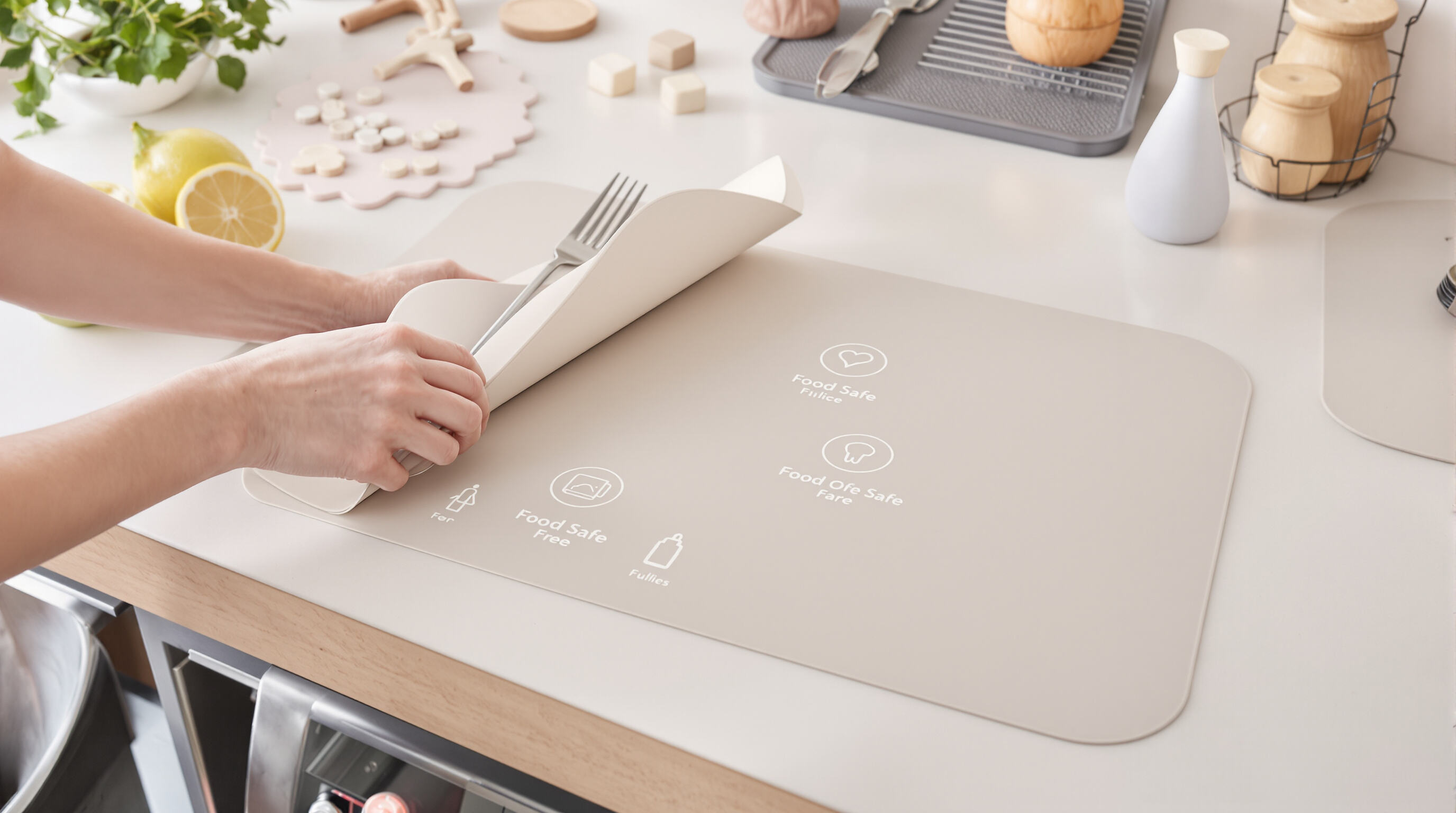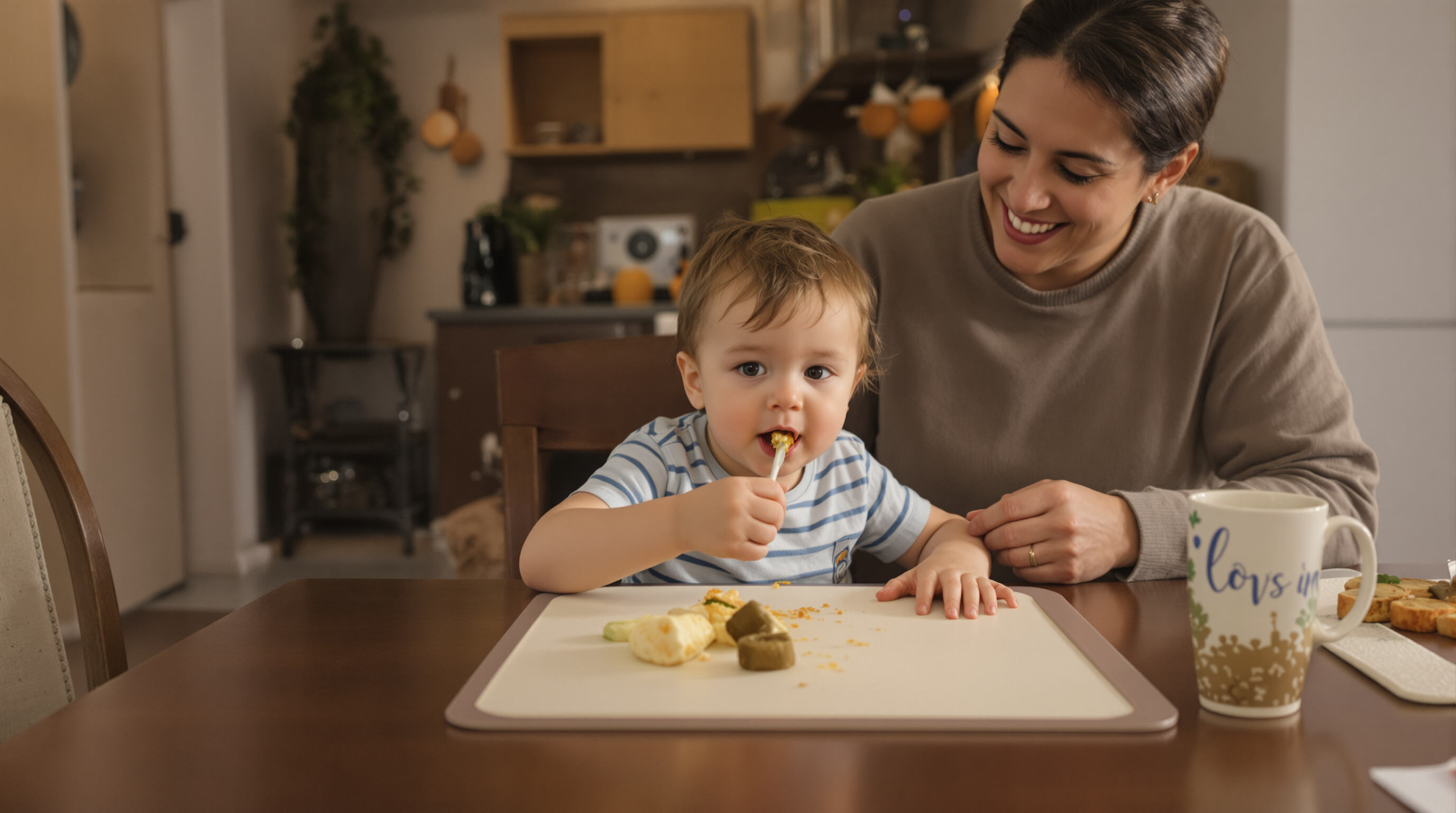Protecting Tables with Heat and Stain Resistance
Heat Resistance and Table Surface Protection
Silicone placemats can handle temperatures as high as 450 degrees Fahrenheit (around 232 Celsius), which makes them great for protecting wooden, marble, or laminate surfaces from getting damaged by hot pans and pots. Regular plastic mats tend to melt or bend under heat while cloth ones often burn or leave marks. The way silicone holds up against heat means it doesn't let much warmth pass through to the table below. So whether someone is placing a steaming hot casserole or a fresh loaf straight out of the oven, the surface stays safe and clean without any warping or discoloration.
Stain-Resistant and Heat-Resistant Properties Prevent Damage
Silicone placemats have a surface that doesn't absorb anything, so they just push away spills, oils, and even those pesky acidic foods we all love like coffee or tomato sauce. Some tests done back in 2022 showed that tables protected by these mats got stained about 80% less than regular tables left unprotected. And when paired with how well they handle heat, this means no more worrying about colors fading or shapes getting messed up after putting down hot dishes again and again. Just think about it next time your favorite mug leaves a ring on the table!
Durability and Longevity of Silicone Products Under Daily Use
Silicone placemats hold up really well even when folded, twisted around corners, and washed repeatedly without showing cracks. According to tests run by Consumer Durables Lab back in 2023, about 95 percent still look good and work properly after at least three years of normal kitchen activity. The stuff just doesn't break down like those cheap plastic mats do. It stands up to everything from hot dishwasher cycles to sunlight exposure and sudden changes in temperature. For anyone looking for something that lasts beyond a few months, silicone is definitely worth considering despite the higher upfront cost.
Ensuring Food Safety: Non-Toxic and Certified Silicone Materials

Safe and Non-Toxic Material for Children and Adults
Silicone placemats of good quality are generally safe for everyone including little ones. They don't contain BPA, phthalates or those nasty additives we all try to avoid these days. The best ones meet FDA food grade standards so nothing bad gets into our food even when things get pretty hot around 200 degrees Celsius according to some research from Ponemon last year. That's why they work great for plates of steaming hot food, jars of baby puree, or anything acidic like lemon slices that would make regular plastic break down over time. Top manufacturers actually go one step further by using what's called platinum cured silicone. This special treatment removes any leftover chemicals and creates surfaces that don't smell weird or taste funny. A recent safety report from 2024 showed that properly certified food grade silicone doesn't release any chemicals even when exposed to heat stress.
Non-Toxic and Food-Safe Properties of Silicone Verified by Standards
Third-party certifications such as LFGB (Europe) and FDA 21 CFR validate silicone’s safety through rigorous testing for heavy metals, volatile compounds, and biological reactivity. Placemats meeting these benchmarks offer measurable benefits:
- 300% greater resistance to staining bacteria than porous materials like wood (Food Safety Journal 2023)
- Non-adsorbent surfaces inhibit microbial growth, cutting cross-contamination risks by 52% compared to cloth
Silicone vs. Plastic in Food Contact Safety: A Balanced Comparison
Unlike many plastics that require chemical additives for heat resistance, silicone is inherently stable. A 2023 comparative study highlights key differences:
| Property | Silicone | BPA-Free Plastic |
|---|---|---|
| Heat resistance (°C) | 220 | 120 |
| Chemical leaching risk | 0% | 18%* |
| Durability (years) | 8–10 | 2–3 |
| *Plastics showed trace leaching after 50 dishwasher cycles (source: Materials Safety Institute). |
Additionally, silicone’s flexibility prevents micro-cracks—common in rigid plastics—that can harbor bacteria over time.
Note: Tables and stats are simplified for readability. Always verify certification labels like FDA or LFGB when purchasing.
Supporting Independent and Stress-Free Mealtimes

Functions of Silicone Mats in Dining and Feeding Routines
Silicone placemats make great barriers against messes on the table, keeping things contained while eating. They really help stop those inevitable spills, which is a lifesaver for households with little ones running around. The rough texture stops dishes from moving around so much, something studies back up showing about 63 fewer accidents happen when compared to just plain old wooden tables according to research published in Pediatric Feeding Journal last year. Beyond practical benefits, these mats actually cut down on mom and dad's headaches during dinner time, making everyone at the table feel more relaxed instead of constantly worried about what might tip over next.
Silicone Baby Table Mat Supports Developmental Independence
Silicone placemats come with those rounded edges and grippy surfaces that really help little ones feed themselves safely. A study from Child Development Research last year showed something interesting too. Kids between 12 and 24 months old tried feeding themselves about 22 percent more often when they had these silicone mats compared to regular table settings. What makes these mats so good? They stick firmly to the table thanks to that suction base underneath. Parents don't have to keep moving plates around all the time, which means they can actually spend more quality time helping their child learn independence during mealtime instead of chasing runaway bowls.
Encouraging Independence During Meals for Toddlers
The American Academy of Pediatrics emphasizes that consistent mealtime independence fosters fine motor development and decision-making skills. Silicone placemats support this growth by:
- Providing clear visual boundaries for food placement
- Enabling easier scooping with raised edges
- Remaining stable during active eating and utensil use
Parents report a 37% reduction in post-meal cleanup stress due to better spill containment (Parenting Science Review 2023).
Case Study: Family Adoption of Silicone Kids Dining Table Mat
A 2023 observational study followed 50 families who adopted silicone placemats over six weeks:
| Metric | Improvement |
|---|---|
| Mealtime duration | 19% faster |
| Self-feeding attempts | 28% increase |
| Post-meal cleanup time | 42% reduction |
Families noted increased toddler confidence and reduced resistance to trying new foods. Researchers attributed these outcomes to the mats’ tactile feedback and effective mess confinement.
Effortless Cleaning and Maintenance for Busy Households
Easy to Clean Placemats with Stain-Resistant Surfaces
Silicone placemats make cleaning up after meals so much easier because they don't absorb stains or liquids. When something spills, it just sits there on top instead of getting soaked into the material, which means no more scrubbing at stubborn messes. According to a recent study by NSF International from last year, families who switched to silicone table mats reported spending about two thirds less time cleaning each week compared to when they had regular fabric or other types of placemats. Most people find that even big spills can be wiped clean with just a quick pass of a wet paper towel or cloth, saving both time and frustration during those busy dinner hours.
Cleaning and Maintenance of Silicone Placemats: Dishwasher Safe and Quick Wipe-Downs
Silicone placemats generally handle dishwashers just fine even when temps hit around 300 degrees Fahrenheit without getting warped or holding onto smells. These mats tend to dry pretty quickly too, usually within about 15 minutes or so because they repel water naturally. When stuck with tough stuff like honey residue or melted cheese bits, giving them a quick dip in warm soapy water for maybe 10 seconds often does the trick. Most folks find their mats last thousands of washes if they steer clear of those harsh scrub brushes that can actually damage the protective layer on top over time.
Portable and Multi-Functional Use Across Dining Environments
Silicone placemats meet modern dining demands with adaptable designs that combine portability, durability, and function. Their slim profile and roll-up convenience make them ideal space-saving tools for travelers, campers, and busy households alike.
Portable Design for Travel, Picnics, and Outdoor Dining
Measuring just 0.2” thick, silicone placemats roll into compact cylinders that fit easily into backpacks or diaper bags. Outdoor diners appreciate their heat resistance (up to 446°F) and waterproof surface when eating on uneven picnic tables or camping gear.
Uses and Benefits of Silicone in the Kitchen Beyond Placemats
Innovative kitchen products now leverage silicone’s versatility:
- Oven-safe baking mats with non-slip textures
- Adjustable pot holders that double as jar openers
- Collapsible mixing bowls with built-in measurement markings
These multi-functional tools help streamline storage while maintaining hygiene and safety standards.
Trend: Multi-Functional Silicone Products Replacing Traditional Tableware
According to a 2023 kitchenware adoption survey, 58% of households now prefer silicone over plastic or wood due to its superior safety, durability, and adaptability. Modern placemat designs integrate features like utensil rests, crumb catchers, and compartmentalized sections—capabilities difficult to achieve with conventional materials without sacrificing heat resistance or portability.
FAQ
Are silicone placemats safe for children?
Yes, silicone placemats are safe for children as they are made without harmful chemicals like BPA and phthalates. They meet FDA food grade standards, ensuring that nothing toxic leaches into food.
Can silicone placemats be used in dishwashers?
Yes, silicone placemats can be safely used in dishwashers as they can withstand high temperatures without warping or retaining odors.
What makes silicone placemats better than plastic?
Silicone placemats are superior to plastic because they are heat resistant, non-toxic, durable, and do not require chemical additives. They do not leach chemicals and have a longer lifespan compared to plastic alternatives.
Do silicone placemats help reduce household cleaning time?
Yes, silicone placemats are stain resistant and easy to clean. Families report spending much less time cleaning compared to using fabric or plastic placemats.

